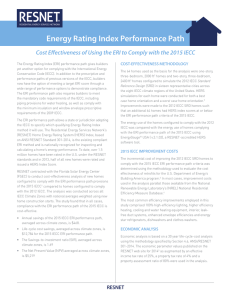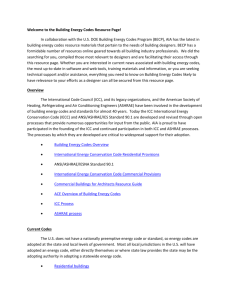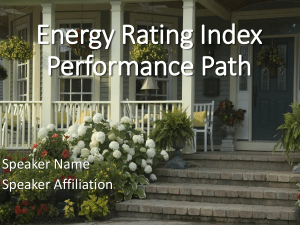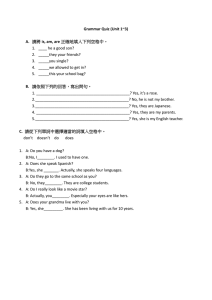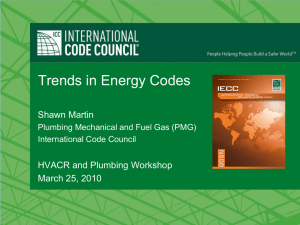Energy Rating Index Performance Path
advertisement
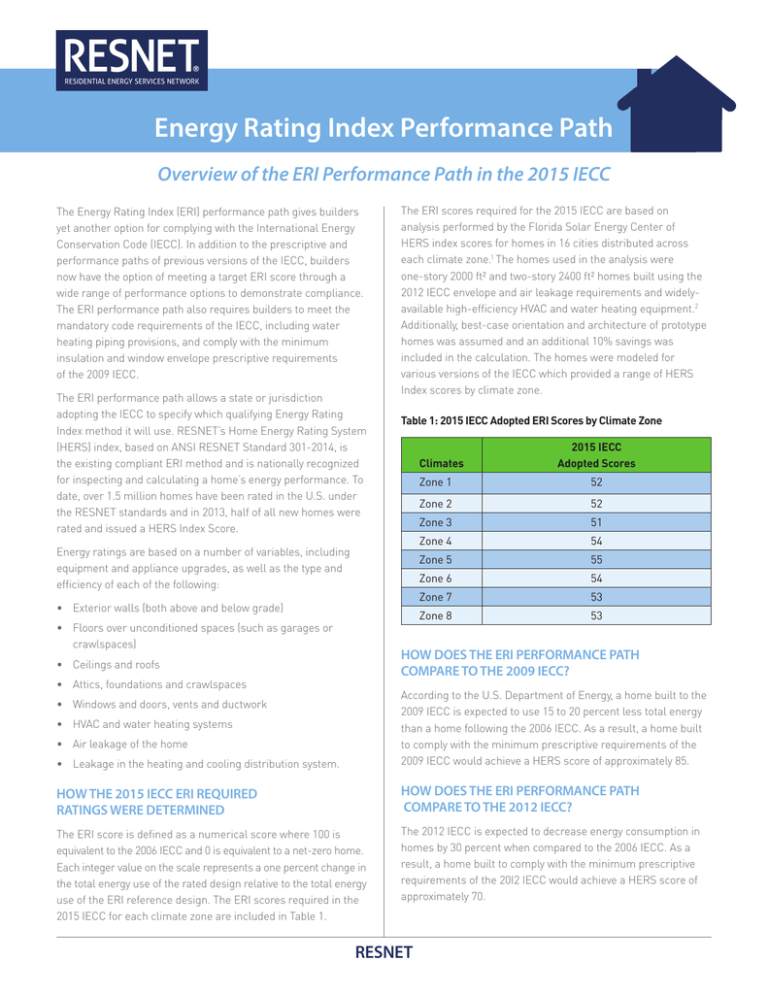
Energy Rating Index Performance Path Overview of the ERI Performance Path in the 2015 IECC The Energy Rating Index (ERI) performance path gives builders yet another option for complying with the International Energy Conservation Code (IECC). In addition to the prescriptive and performance paths of previous versions of the IECC, builders now have the option of meeting a target ERI score through a wide range of performance options to demonstrate compliance. The ERI performance path also requires builders to meet the mandatory code requirements of the IECC, including water heating piping provisions, and comply with the minimum insulation and window envelope prescriptive requirements of the 2009 IECC. The ERI performance path allows a state or jurisdiction adopting the IECC to specify which qualifying Energy Rating Index method it will use. RESNET’s Home Energy Rating System (HERS) index, based on ANSI RESNET Standard 301-2014, is the existing compliant ERI method and is nationally recognized for inspecting and calculating a home’s energy performance. To date, over 1.5 million homes have been rated in the U.S. under the RESNET standards and in 2013, half of all new homes were rated and issued a HERS Index Score. The ERI scores required for the 2015 IECC are based on analysis performed by the Florida Solar Energy Center of HERS index scores for homes in 16 cities distributed across each climate zone.1 The homes used in the analysis were one-story 2000 ft² and two-story 2400 ft² homes built using the 2012 IECC envelope and air leakage requirements and widelyavailable high-efficiency HVAC and water heating equipment.2 Additionally, best-case orientation and architecture of prototype homes was assumed and an additional 10% savings was included in the calculation. The homes were modeled for various versions of the IECC which provided a range of HERS Index scores by climate zone. Table 1: 2015 IECC Adopted ERI Scores by Climate Zone Climates Energy ratings are based on a number of variables, including equipment and appliance upgrades, as well as the type and efficiency of each of the following: • Exterior walls (both above and below grade) • Floors over unconditioned spaces (such as garages or crawlspaces) 2015 IECC Adopted Scores Zone 1 52 Zone 2 52 Zone 3 51 Zone 4 54 Zone 5 55 Zone 6 54 Zone 7 53 Zone 8 53 HOW DOES THE ERI PERFORMANCE PATH COMPARE TO THE 2009 IECC? • Ceilings and roofs • Attics, foundations and crawlspaces • Leakage in the heating and cooling distribution system. According to the U.S. Department of Energy, a home built to the 2009 IECC is expected to use 15 to 20 percent less total energy than a home following the 2006 IECC. As a result, a home built to comply with the minimum prescriptive requirements of the 2009 IECC would achieve a HERS score of approximately 85. HOW THE 2015 IECC ERI REQUIRED RATINGS WERE DETERMINED HOW DOES THE ERI PERFORMANCE PATH COMPARE TO THE 2012 IECC? The ERI score is defined as a numerical score where 100 is equivalent to the 2006 IECC and 0 is equivalent to a net-zero home. Each integer value on the scale represents a one percent change in the total energy use of the rated design relative to the total energy use of the ERI reference design. The ERI scores required in the 2015 IECC for each climate zone are included in Table 1. The 2012 IECC is expected to decrease energy consumption in homes by 30 percent when compared to the 2006 IECC. As a result, a home built to comply with the minimum prescriptive requirements of the 20I2 IECC would achieve a HERS score of approximately 70. • Windows and doors, vents and ductwork • HVAC and water heating systems • Air leakage of the home RESNET Energy Ratings Index Performance Path HOW DOES THE ERI PERFORMANCE PATH COMPARE TO OTHER STANDARDS? WHO IS USING THE HERS INDEX? A study performed by the Leading Builders of America and the National Association of Home Builders Research Center found the corresponding HERS index scores for Energy STAR, a level of 50% beyond the 2006 IECC and a level 60% beyond the 2006 IECC to be 70, 56 and 47, respectively. Across the nation, state and local governments are adding a HERS Index Score target as a performance compliance option to their building energy code. To date, code jurisdictions in the states of Arkansas, Colorado, Idaho, Kansas, New Mexico, New York and Massachusetts have incorporated a HERS Index Score option into their residential energy codes.3 Table 2 depicts the current average HERS index rating for each climate zone based on the number of homes receiving HERS ratings from March 2012 to March 2014 Table 2: Average HERS Index by Climate Zone Climate Zone 70 85 100 2012 2009 2006 IECC IECC IECC Number of Homes Rated Average HERS Index 1A 1442 68 1B 5 58 2A 60857 65 2B 5080 62 3A 40590 66 3B 7040 63 3C 18 78 4A 49073 64 4B 1720 56 4C 754 61 5A 52706 62 5B 14706 61 6A 8744 56 6B 690 59 7A 82 56 7B 213 62 8B 2 52 1 http://www.resnet.us/uploads/documents/FSEC-CR-1941-13_R01.pdf 2 SEER 16 air conditioners in the South, SEER 14.5 in the north, 94% AFUE furnaces in the North (5-8), 90% AFUE furnaces in climate zones 3-4, 8.7 HSPF, and point-of-use gas or ENERGY STAR® electric water heaters. 3 For a listing of jurisdictions that have incorporated a HERS Index Score into their energy code see http://resnet.us/professional/main/Hers_index_and_energy_codes. RESNET Developed by Britt/Makela Group (brittmakela.com)

